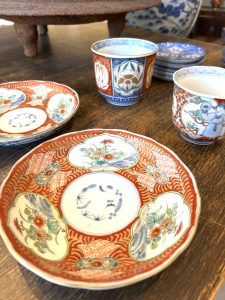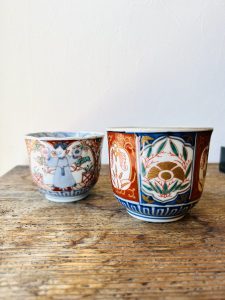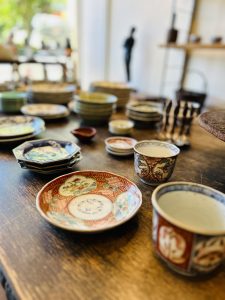季節に影響されております(愛知県名古屋市千種区姫池通 骨董買取 古美術風光舎)
2023.10.18
皆さまこんにちは。スタッフHでございます。
気持ちのいい秋晴れが続いていますね。エアコンの必要のない生活に体が喜んでいる気がします。ほんのひと時の贅沢な季節ですね。
暑い盛りには藍色の器に目が向きがちでしたが、今は艶やかな古伊万里に惹かれております。気候や季節に影響されているのでしょうか。温かみのある朱色に気持ちが和らぎます。

左奥の赤絵の蕎麦猪口の高台の中には「富貴長春」という言葉が書かれています。中国、宋の時代からのお祝いの言葉で、繁栄と幸福、長寿を象徴していると言われています。他にも縁起の良い絵柄のふくら雀は真ん丸にふくれた雀の異称で、寒さをしのぐために羽を膨らませた状態を表すそうです。ふくふくと肥えふくれたその佇まいから、食べ物に飢えることなく子孫繁栄していくようにと願いが込められています。竹や笹は成長がとても早く、生命力の象徴として扱われたり殺菌力が強いため、古くから魔除けや神聖なものとして扱われてきました。器を手に収めるだけで幸福感がましそうです。
中国風の衣装を着た童子の小鉢も愛らしいです。手に持っているのはシンバル?でしょうか。また妄想が膨らみます。

赤絵の小皿はまさに私がイメージする華やかな伊万里焼の絵柄です。
いつもの如くイメージのみが先行しておりますので、少し勉強させてくださいね。
赤絵とは白磁の上に赤を主調とした顔料で上絵づけした陶磁器と、低火度で赤を主体として、緑・黄・紫・青・などの上絵具を焼き付ける手法のことをいいます。中国では宋代から作成され、日本では1600年代に柿右衛門が取り入れ、同時期に九谷でも行われるようになったと言われています。
赤絵の技術で最も難しい発色は赤でした。初代柿右衛門が試行錯誤の末、資金をつくし、最後に壁板をはがして燃料にして、ついに赤絵に成功した、という逸話も残っているとか。
当時染付の単色しかなかった中で、これらの焼き物は革新的といえるものだったでしょう。
「柿右衛門様式」に続き元禄期(1688~1704)に生まれた「古伊万里様式」では、赤・青・黄・緑・紫の色釉を用い、赤絵の中でも金色を施した有田独自の様式は「古伊万里金襴手」と呼ばれています。
柿右衛門同様にヨーロッパで好まれ、元禄から享保にかけて大量に輸出されました。余白がないほど文様が描きこまれた絢爛豪華で多様な絵付けは豊かな時代を反映しているともいえます。
構図の特徴は、器を中心から放射状に直線や唐花の曲線で区切り、窓絵(まどえ)と地文様を交互に描いていること。文様にはから唐花文や獅子牡丹文などがあります。
この緻密なデザインに加え、この艶やかな色彩を表現するためには色によって焼成する温度を変える必要があり、少なくとも4回は焼成する必要があります。
買い手の要望に答えるというだけではなく、美しいものを作りたいという作り手の思いが伝わってきますね。

それでは、またお会いしましょう。
Hello everyone. This is Staff H.
The pleasant autumn weather is continuing, isn’t it? Life without the need for air conditioning is kind both mentally and physically. It is a season of luxury for a moment.
I was apt to look at the indigo-colored dishes in the heat of the season, but now I am attracted to the glossy Ko-Imari. Is it influenced by the climate or the season? The warm vermilion color makes me feel at ease.
The words “wealth, beauty, and long spring” are written in the high stand of the red-painted buckwheat noodle cup at the back left. It is said to symbolize prosperity, happiness, and longevity. Another auspicious design is the puffy sparrow, another name for a sparrow that has puffed up its wings to ward off the cold. The plump and swollen appearance of the sparrows is said to express the wish that they will never be hungry for food and that their offspring will prosper and flourish. Bamboos and bamboos grow very fast and have been treated as symbols of vitality and sterilizing power, so they have long been considered sacred and used to ward off evil.
The small bowl of children dressed in Chinese-style costumes is also adorable. Is that a cymbal in his hand? Is it a cymbal? My imagination is growing again.
The small red-painted plate is exactly the image I have of gorgeous Imariyaki ware.
As usual, only the image comes first, so please allow me to study it a little.
Akae refers to ceramics overglaze painted with red pigments on white porcelain, or overglaze paints of green, yellow, purple, blue, etc., mainly in red, fired at low temperatures. It is said to have been created in China since the Song Dynasty, and in Japan, Kakiemon introduced this technique in the 1600s, and Kutani began to use it at the same time.
The most difficult color to produce in the technique of akae was red. There is an anecdote that Kakiemon I devoted all his resources to red painting after much trial and error, and finally succeeded by tearing off the wallboard and using it as fuel.
These ceramics must have been revolutionary, as only monochrome underglaze blue ware was available at the time.
In the “Ko-Imari style” that followed the “Kakiemon style” and was born in the Genroku period (1688-1704), red, blue, yellow, green, and purple colored glazes were used, and the unique Arita style of red painting with gold color is called “Ko-Imari Kinrande”.
Like Kakiemon, it was favored in Europe and exported in large quantities from Genroku to Kyoho period. The gorgeous and various painted patterns, which are so rich that there is no space to spare, can be said to reflect the richness of the times.
The composition is characterized by the use of straight lines and curved lines of arabesque patterns radiating from the center of the vessel, and the alternation of window paintings and ground patterns. The patterns include arabesque and lion and peony designs.
In addition to this intricate design, the firing temperature must be changed for each color to express these lustrous colors, requiring at least four firings.
This shows the creator’s desire to create something beautiful, not just to meet the buyer’s needs.
So, I will see you again.
*******************
ご実家の整理やお片付けなどをされている方のご相談などが多くございます。
お片付けなどくれぐれもご無理のないようになさってくださいませ。
風光舎では古美術品や骨董品の他にも絵画や宝石、趣味のお品など様々なジャンルのものを買受しております。
お片付けをされていて、こういうものでもいいのかしらと迷われているものでも、どうぞお気軽にご相談下さいませ。
また風光舎は、出張買取も強化しております。ご近所はもちろん、愛知県内、岐阜県、三重県その他の県へも出張いたします。
まずは、お電話お待ちしております。
愛知県名古屋市千種区姫池通
骨董 買取【古美術 風光舎 名古屋店】
TEL052(734)8444
10:00-17:00 OPEN
#出張買取#骨董#古美術#骨董品#絵画#版画#茶道具#刀剣#彫刻

